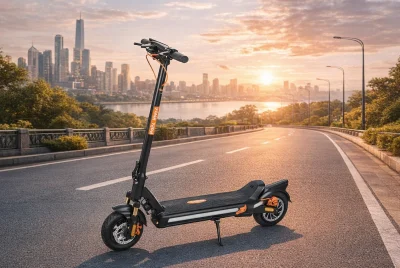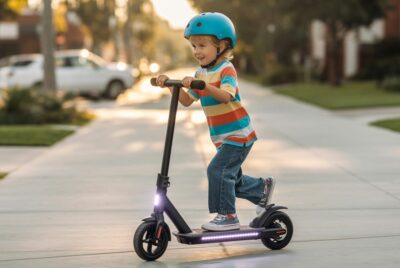How to Choose the Right Electric Scooter
*We may earn a commission for purchases made using our links. Please see our disclosure to learn more.
Choosing the right electric scooter can feel overwhelming with so many options available, from budget-friendly models to high-performance rides. Whether you’re looking for a daily commuter, an off-road adventure scooter, or something lightweight for short trips, the key is understanding your specific needs.
This guide will break down the most important factors, battery life, speed, terrain compatibility, and portability, to help you make an informed decision. Plus, I’ll highlight some top-rated scooters across different categories to match various lifestyles and budgets. Let’s find the perfect ride for you!
Key Takeaways
- Know your purpose: Determine whether you need a scooter primarily for commuting, recreation, or off-road adventures
- Consider your route: Analyze your typical terrain and distance to choose appropriate motor power and battery capacity
- Weight and portability: Factor in how often you’ll need to carry your scooter and whether it needs to fold for storage
- Budget wisely: The best scooter isn’t always the most expensive; focus on the features that matter for your needs
- Safety features: Never compromise on quality brakes, lights, and tires regardless of your budget
Top Recommended Electric Scooters
After testing dozens of models, here are four of the right electric scooters I highly recommend, each excelling in a different category.
1. Segway Ninebot MAX G30LP – Best Overall Commuter
The Segway Ninebot MAX Electric Kick Scooter is designed for riders who want a balance of speed, durability, and convenience. Featuring a powerful 350W motor, this scooter reaches speeds of up to 18.6 mph and offers an impressive 25-mile range on a single charge. Built with 10-inch pneumatic tires and a shock absorption system, it delivers a smooth and stable ride, even on uneven terrain. Weighing only 38.6 lbs, it folds easily for portability, making it perfect for daily commutes or urban adventures. Certified to UL-2272 safety standards, the MAX G30LP ensures reliability, efficiency, and top-tier performance.
- Long Battery Life – Travel up to 25 miles on a single charge.
- Smooth Ride – 10-inch tires with shock absorption for enhanced comfort.
- Foldable & Portable – Lightweight design for easy transport and storage.
- No Dual Suspension – Shock absorption is decent but not as smooth as the MAX G2 model.
- Limited Weight Capacity – Supports up to 220 lbs, which may not suit all riders.
- Slower on Steep Hills – Performance may decrease on inclines above 20%.
Price: $699.99
- Range: Up to 25 miles
- Top Speed: 18.6 mph
- Weight: 38.6 lbs
- Why I love it: The perfect balance of range, durability, and value. The 10-inch pneumatic tires handle city streets beautifully, while the reliable braking system and bright LED lights make it one of the safest options for daily commuters.
2. Gotrax GXL V2 – Best Budget Option
The Gotrax GXL V2 Electric Scooter is an affordable and reliable choice for daily commuters and casual riders. Powered by a 250W motor, it reaches speeds of up to 15.5 mph and offers a 9-mile range on a single charge. The 8.5-inch solid tires are maintenance-free, ensuring a smooth ride without the risk of flats. Weighing only 27 lbs, it folds easily for convenient storage and transport. Built with an aluminum alloy frame, cruise control, and UL2272 safety certification, the GXL V2 is designed for both safety and comfort.
- Lightweight & Portable – Weighs only 27 lbs and folds for easy carrying.
- Maintenance-Free Tires – Solid 8.5-inch tires eliminate the risk of flats.
- Cruise Control Feature – Allows for a more effortless and smooth ride.
- Limited Range – Maximum of 9 miles per charge may not be ideal for long commutes.
- Slower Acceleration – 250W motor is reliable but less powerful than higher-end models.
- No Suspension System – Ride may feel bumpier on rough roads.
Price: $299.99
- Range: Up to 9 miles
- Top Speed: 15.5 mph
- Weight: 27 lbs
- Why I love it: The Gotrax GXL V2 is a lightweight, budget-friendly commuter scooter that doesn’t compromise on reliability. The solid 8.5-inch tires eliminate flats, while the foldable aluminum frame makes it easy to carry. With cruise control and a 250W motor, it’s a great option for short city rides.
3. Apollo Go Electric Scooter – Best Performance Scooter
The Apollo Electric Scooter is a high-performance commuter scooter designed for adults seeking speed, power, and comfort. With dual 350W motors (1,500W peak output), it reaches speeds of up to 28 mph and can handle 25% grade hills with ease. The 21700 battery cells offer an impressive range of 30 miles in eco mode, making it ideal for longer commutes. Featuring self-healing tires, advanced suspension, and a 360° lighting system, the Apollo ensures a safe, smooth, and worry-free ride.
- High-Speed Performance – Reaches up to 28 mph with strong acceleration.
- Long Battery Life – Up to 30 miles per charge for extended rides.
- Advanced Suspension – Smooth ride with front spring & rear rubber suspension.
- Higher Price Point – Costs significantly more than entry-level models.
- Heavy Weight – At 46 lbs, it may be less portable for some riders.
- Limited Sport Mode Range – Only 15 miles in high-speed mode.
Price: $1,249.00
- Range: Up to 30 miles
- Top Speed: 28 mph
- Weight: 46 lbs
- Why I love it: The Apollo Go is built for power and endurance. With dual 350W motors, self-healing pneumatic tires, and an advanced suspension system, it handles city streets with ease. The 360° lighting system and regenerative braking add safety and efficiency, making it ideal for longer commutes.
4. Hiboy S2 Pro – Best Mid-Range Option
The Hiboy S2 Pro/S2 MAX is a sleek, high-performance electric scooter designed for efficient commuting and urban travel. Equipped with a 500W motor, it reaches speeds of up to 19 mph and offers a range of up to 40.4 miles (S2 MAX model). Its 10-inch solid tires and dual rear shock absorbers provide a smooth ride on various terrains. The foldable design and optional seat make it versatile for riders who prioritize both comfort and portability.
- Powerful Performance – 500W motor with a max speed of 19 mph
- Long-Lasting Battery – Up to 40.4 miles on a single charge (S2 MAX)
- Comfortable Ride – 10-inch solid tires with rear dual shock absorbers
- Solid Tires – Less cushioning compared to air-filled tires
- No Built-in Suspension – Relies on shock absorbers for comfort
- Seat Sold Separately – Must be purchased separately for seated riding
Price: $449.99
- Range: Up to 40.4 miles (S2 MAX)
- Top Speed: 19 mph
- Weight: 36.3 lbs
- Why I love it: The Hiboy S2 Pro offers the perfect mix of performance and convenience. With a 500W motor, solid puncture-proof tires, and rear shock absorbers, it delivers a smooth and worry-free ride. Ideal for commuters who want reliability and comfort at an affordable price.
Understanding Your Needs: The First Step
Daily Commuting vs. Recreational Riding
Before diving into technical specifications, I always ask myself: what am I primarily using this scooter for? If you’re looking for the right electric scooter for daily commuting, reliability, range, and portability should be your priorities. I’ve found that commuter scooters should be able to travel at least 5 miles further than your daily route to account for battery degradation over time.
For recreational riding, you might prioritize speed, ride comfort, and off-road capabilities instead. During weekend trail rides, I appreciate having wider tires and better suspension much more than when I’m cruising down smooth bike lanes on my way to work.
Route Analysis: Distance, Terrain, and Hills
The terrain you’ll be riding on significantly impacts which scooter will serve you best. Here’s what I’ve learned:
- Flat urban environments: Most mid-range scooters with 250-350W motors will serve you well
- Hilly areas: Look for at least 500W of motor power and good battery capacity
- Rough terrain: Prioritize models with suspension systems and larger pneumatic tires
- Long distances: Focus on battery capacity (ideally 10Ah or higher)
I made the mistake of buying an underpowered scooter for my hilly neighborhood once. The struggle up inclines drained the battery quickly and made every commute a challenge. Don’t repeat my error—match your scooter’s capabilities to your environment.
Essential Specifications Explained
Motor Power: Understanding Watts and Torque
The motor is the heart of your electric scooter, and its power rating (measured in watts) gives you a good idea of what it can handle:
- 250-350W: Suitable for flat terrain and riders under 180 lbs
- 350-500W: Good for moderate hills and heavier riders
- 500-1000W: Excellent hill climbing ability and acceleration
- 1000W+: Premium performance, significant torque, and speed
I’ve noticed that many manufacturers list peak power rather than continuous power. When comparing models to find the right electric scooter, try to find the continuous power rating for a more accurate comparison.
Battery Life and Range
Nothing is more frustrating than range anxiety, that constant worry about whether you’ll make it to your destination. Remember that manufacturer range estimates often assume ideal conditions. In real-world conditions, especially with hills or cold weather, expect 70-80% of the advertised range.
When choosing battery capacity, consider:
- For short commutes (under 5 miles): 6-8Ah batteries (roughly 15-20 mile range)
- For medium commutes (5-10 miles): 10-15Ah batteries (roughly 25-30 mile range)
- For long commutes (10+ miles): 15Ah+ batteries (30+ mile range)
Weight, Portability, and Folding Mechanisms
I learned this lesson the hard way: a scooter’s weight dramatically affects its practicality. Consider:
- Under 30 lbs: Easy to carry up stairs, onto public transit, or into offices
- 30-40 lbs: Manageable for short carries but becomes uncomfortable quickly
- 40+ lbs: Primarily designed to be ridden rather than carried
Beyond weight, evaluate the folding mechanism. Some fold down in seconds with a simple latch, while others require multiple steps. I’ve found that the quality of the folding mechanism is just as important as its design, cheap latches can come loose while riding, creating dangerous situations. Choosing the right electric scooter means prioritizing a sturdy and reliable folding system for safety and convenience.
Tires: Pneumatic vs. Solid
After testing both types extensively, I strongly believe that pneumatic (air-filled) tires provide a superior riding experience in most situations:
- Pneumatic tires: Better shock absorption, improved grip, smoother ride
- Solid tires: Never go flat, zero maintenance, but transmit every bump to your body
If you choose pneumatic tires, consider models with self-healing fluid pre-installed or tubeless designs to reduce puncture risks. For solid tires, look for models with additional suspension to compensate for the harsher ride.
Braking Systems: Safety First
No matter your budget, never compromise on braking systems. The best electric scooters offer redundant braking methods:
- Disc brakes: Offer the best stopping power in all conditions
- Drum brakes: Good performance with minimal maintenance
- Electronic brakes: Convenient but should be paired with mechanical systems
- Foot brakes: Simple backup system that requires no electronics
I always recommend having at least two independent braking systems. When you need to stop suddenly, you’ll be grateful for the redundancy.
Suspension Systems: Comfort on the Go
After riding scooters with and without suspension, I can confidently say that suspension systems make a significant difference in ride quality, especially on uneven surfaces:
- Spring suspension: Common and effective for general use
- Hydraulic suspension: Superior performance but more expensive
- Dual suspension: Provides the smoothest ride but adds weight
For primarily smooth surfaces like bike lanes and well-maintained roads, you might be able to skip suspension in favor of large pneumatic tires. For mixed terrain, some form of suspension is worth the investment.
Build Quality and Durability
Water Resistance Ratings
Most electric scooters aren’t designed for riding in heavy rain, but choosing the right electric scooter with a good water resistance rating ensures it won’t be damaged by light rain or puddles. Look for:
- IPX4: Protected against water splashes from any direction
- IPX5 or higher: Better protection against low-pressure water jets
I’ve seen too many friends’ scooters fail after getting caught in unexpected rain, don’t underestimate the importance of water resistance.
Frame Materials and Construction
The materials used in your scooter’s construction directly impact its durability and weight:
- Aircraft-grade aluminum: Offers the best strength-to-weight ratio
- Steel components: Extremely durable but heavier
- Plastic components: Lightweight but less durable
Pay special attention to the stem (the vertical bar connecting the handlebars to the deck), as this receives the most stress during riding.
Additional Features Worth Considering
Lighting Systems
Good lighting isn’t just about seeing the road, it’s about being seen by others. I recommend:
- Front light: At least 200 lumens, ideally adjustable
- Rear light: Bright red with flashing mode options
- Deck lighting: Not essential but improves visibility from the side
Many entry-level scooters come with inadequate lighting. If that’s the case with your chosen model, budget for aftermarket lights.
Display and Controls
Most modern scooters come with some form of display, from simple LED indicators to full LCD screens. In my experience, a good display should show:
- Current speed: Preferably in both mph and km/h
- Battery level: Percentage is much more useful than bar indicators
- Odometer: Helps track maintenance intervals
- Riding mode: Clear indication of your current speed setting
Safety Considerations
Personal Protective Equipment
No matter how cautious you are, falls happen. I always recommend:
- Helmet: Absolutely essential, no exceptions
- Gloves: Protect your hands in case of falls
- Reflective clothing: Improves visibility, especially at dawn/dusk
After my first fall at just 12 mph left me with road rash that took weeks to heal, I never ride without proper gear, regardless of the distance.
Rider Skill Development
Even the best scooter won’t protect an unskilled rider. Before taking your new scooter into traffic:
- Practice in empty parking lots
- Master emergency stops
- Learn to scan for road hazards
- Understand defensive riding techniques
Take the time to develop these skills, they’re just as important as choosing the right scooter.
Budget Considerations: Getting the Best Value
Price Ranges and What to Expect
Electric scooters generally fall into these price categories:
- $300-500: Entry-level commuters with basic features
- $500-1000: Mid-range models with improved range, comfort, and durability
- $1000-1500: Premium commuters with excellent range and feature sets
- $1500+: High-performance and off-road models
I’ve found that the sweet spot for value tends to be in the $700-900 range, where you get significant improvements over budget models without paying for features most riders rarely use.
Long-Term Ownership Costs
The purchase price is just the beginning. Consider these additional costs:
- Replacement batteries: Eventually needed after 300-500 charge cycles
- Tire replacements: Especially important with pneumatic tires
- Maintenance: Brake adjustments, bearing replacements, etc.
A quality scooter that costs slightly more upfront but requires less maintenance may prove more economical over its lifetime.
Conclusion
Choosing the right electric scooter involves balancing technical specifications, practical considerations, and personal preferences. By thoroughly assessing your needs, commuting distance, terrain, portability requirements, and budget, you can narrow down the overwhelming number of options to find your perfect match.
Remember that the “best” scooter isn’t necessarily the most expensive or feature-packed model, but rather the one that aligns most closely with your specific requirements. Whether you opt for the excellent all-around capabilities of the Segway Ninebot MAX, the budget-friendly functionality of the Gotrax GXL V2, the high performance of the Apollo Go, or the mid-range value of the Hiboy S2 Pro, make your choice based on how you’ll actually use your scooter.
Electric scooters represent not just a convenient mode of transportation but also a more sustainable and enjoyable way to navigate urban environments. With the right electric scooter underneath you, those daily commutes transform from mundane journeys into something you actually look forward to, I know mine certainly have.
FAQs
How long do electric scooter batteries typically last?
Most quality electric scooter batteries will last between 300-500 full charge cycles before noticeable capacity degradation occurs. In practical terms, this means 2-3 years of regular use for most riders. To maximize battery lifespan, I recommend avoiding completely draining the battery and storing the scooter at around 40-60% charge when not in use for extended periods.
Are electric scooters legal to ride everywhere?
Regulations vary significantly by location. In most areas, electric scooters are permitted on bike lanes and roads with speed limits under 25-30 mph, but many cities prohibit sidewalk riding. Some regions require helmets, lights, and reflectors, while others have age restrictions. Before purchasing, check your local transportation department’s website for specific regulations.
How do I maintain my electric scooter?
Regular maintenance greatly extends your scooter’s lifespan. I recommend a monthly check of: tire pressure (for pneumatic tires), brake adjustments, all fasteners and folding mechanisms, and cleaning of exposed electronics. Additionally, store your scooter indoors in a dry place and avoid riding through deep puddles or heavy rain.
Can I take my electric scooter on public transportation?
This varies by transit system, but many buses, trains, and subways allow folded electric scooters, especially lighter models under 40 pounds. Some systems have specific policies regarding battery-powered vehicles or size restrictions. In my experience, compact folding scooters rarely present problems during off-peak hours, but may be restricted during rush hour on crowded systems.
How fast do electric scooters go?
Consumer electric scooters typically have maximum speeds between 15-20 mph for entry and mid-range models, while high-performance scooters can reach 30+ mph. However, many regions limit electric scooters to 15-20 mph on public roads regardless of their technical capabilities. In my experience, 15-18 mph provides a good balance between progress and safety in urban environments.
















